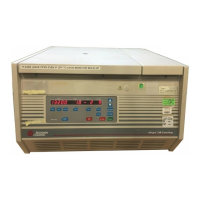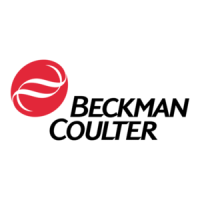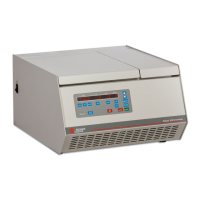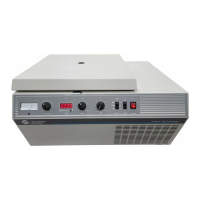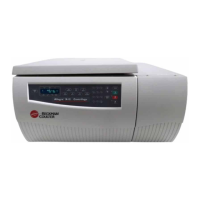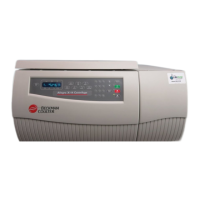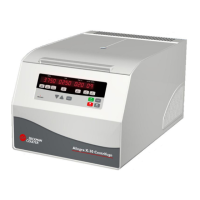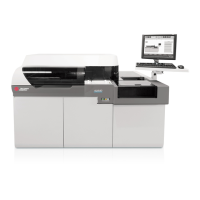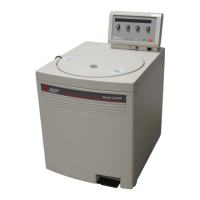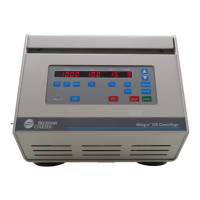
Do you have a question about the Beckman Coulter Allegra 21 Series and is the answer not in the manual?
| Brand | Beckman Coulter |
|---|---|
| Model | Allegra 21 Series |
| Category | Laboratory Equipment |
| Language | English |
Safety guidelines for installing and maintaining the centrifuge, including weight and servicing precautions.
Safety measures for electrical connections, including grounding, voltage, and plug usage.
Precautions regarding fire risk, including fuse replacement and use of flammable materials.
Safety procedures for operating the centrifuge, covering rotor handling, speed limits, and clearance requirements.
Guidelines for handling hazardous materials, aerosols, and proper disposal procedures.
Information regarding the manufacturing quality and regulatory compliance of the centrifuges.
Overview of the manual's content, covering instrument specifications, operation, and maintenance.
Explanation of symbols used for safety and important information in the manual.
Explains typographic conventions used for UI elements like keys and display names.
Information about the absence of CFCs in the centrifuge manufacturing and operation.
Details on the instrument's compliance with radio interference regulations and potential user responsibilities.
Explanation of the WEEE recycling label and disposal guidelines for electrical equipment.
Overview of the centrifuge's capabilities and applications in generating centrifugal forces for various laboratory tasks.
Overview of the centrifuge's capabilities and applications in generating centrifugal forces for various laboratory tasks.
Describes the availability of both nonrefrigerated and refrigerated models and their similarities.
Details the safety features integrated into the centrifuges, including door locks, barriers, and imbalance detection.
Information about the name rating plate, its location, and the data it provides for identification.
Description of the centrifuge's chassis construction and materials.
Details about the centrifuge housing and control panel materials.
Explanation of the door locking mechanism and safety features, including manual override for emergencies.
Description of the rotor chamber, including its components like the drive shaft and gasket system.
Information on the brushless three-phase direct-drive motor and its features for operation and longevity.
Explanation of the temperature control system in refrigerated models, including thermistor monitoring and user settings.
Overview of the controls and indicators on the centrifuge, including power switch and displays.
Location and function of the two-position power switch for controlling the centrifuge's electrical power.
Overview of the control panel, its layout, touch keys, digital displays, and imbalance indicator.
Details the function and operation of the system keys on the control panel, including START, STOP, and OPEN DOOR.
Explanation of the program keys used for setting run parameters like speed, time, and temperature.
Describes the function of the digital displays for speed, time, temperature, and acceleration/deceleration profiles.
General guidelines for installing the centrifuge, including placement and environmental considerations.
Details the electrical requirements, voltage, frequency, and power cord specifications for the centrifuge.
Instructions for performing a test run to ensure the centrifuge is in proper operating condition after shipment.
Detailed operating procedures for the centrifuge, covering setup, run execution, and unloading.
Steps for preparing and loading the rotor, including temperature equilibration and tie-down screw removal.
Step-by-step guide for entering run parameters such as rotor number, speed, time, and temperature.
Instructions on how to select and enter the correct rotor number for operation.
Guidance on setting the centrifuge speed, either in RPM or RCF.
Detailed steps for setting the rotational speed in Revolutions Per Minute (RPM).
Detailed steps for setting the rotational speed in Relative Centrifugal Field (RCF).
Instructions for setting the run duration for timed or continuous operation.
Procedures for setting the desired temperature for refrigerated models.
Guidance on selecting acceleration rates to protect delicate gradients or for pelleting runs.
Guidance on selecting deceleration rates to maintain separation and protect gradients.
Steps for initiating a centrifuge run after setting parameters, including checks and starting the process.
Instructions on how to adjust run parameters like speed and time while the centrifuge is operating.
Procedures for stopping a centrifuge run using normal or fast stop modes.
Instructions for unloading the rotor and its contents after the run is completed.
A concise summary of the steps involved in performing a centrifuge run.
Information on interpreting and responding to error messages and user alerts displayed by the centrifuge.
Discusses potential malfunctions not indicated by specific error messages and how to address them.
Procedures for manually accessing the rotor chamber in case of power failure or other emergencies.
General information about centrifuge maintenance procedures and responsibilities.
Regular procedures to ensure continued performance and longevity of the centrifuge.
Step-by-step instructions for replacing the rotor chamber gasket if it is damaged or worn.
Recommended cleaning procedures for the centrifuge and its components to prolong its lifespan.
Procedures for cleaning the rotor chamber in case of glass tube breakage.
Procedures for decontaminating the instrument if contaminated with radioactive or pathogenic solutions.
Information on using ethanol for surface cleaning and disinfection, and consulting safety officers.
Guidelines for storing and transporting the centrifuge, including packaging and environmental conditions.
Guidelines for storing the centrifuge for extended periods, including container use and environmental conditions.
Procedures for obtaining authorization and preparing a centrifuge for return.
Lists of replacement parts and supplies available for order, including contact information.
A chart to record and reference run parameters for easy duplication of experimental conditions.
Conditions under which the warranty is released, including modifications and repairs.
Disclaimer of warranties and limitation of liability for consequential damages.
